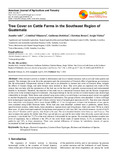| dc.description.abstract | Often livestock activity is related to deforestation and loss of natural resources such as soil and water quality and
quantity. The strategies that come from this perception seek the minimization of livestock effect of greenhouse gas emissions
into the environment. Silvopastoral systems is been used as an alternative to increase tree cover on livestock farms, mitigate
the effects of climate change, and make farmers more resilient to these. Tree cover plays an important role inside of this
system, they can help with the optimization of the land use on the farm and it provides socioeconomical and environmental
benefits to the farmers. Therefore, the objective of this study was to characterize livestock farms and the floristic composition
of tree cover in the southeast region of Guatemala. This region belongs to the dry corridor of Central America and present high
vulnerability to drought. Thirty farms were selected using seven criteria, on each farms a socioeconomical survey was applied
to recollect biophysical, socioeconomical and productive information. Two groups of farms were identified: 1) farms with high
level technological innovation (HLTI) and 2) farms with low level of technological innovation (LLTI). Tree data were obtained
from individuals with diameter above breast height (DBH) of >5 cm. Composition, richness and abundance of tree species
were evaluated using Q-Hill Diversity Index. Seven land uses were identified: scattered trees in paddocks, natural forest,
agrisilvicultural systems, fodder banks, forest plantations, riparian forest and living fences. Study area were 790 ha in which
there were 143 plots distributed randomly, living fences were present in 1.691 km (169.1 ha) with 44 transects. A total of 4,678
trees, from 37 families and 83 species, were found in the area. The most abundant families were Fabaceae and Pinaceae. The
most common tree species for timber were Pinus spp and Quercus spp and for non-timber were Gliricidia sepium and Acacia
pennatula. It was found that 77.27% of the total inventory is dominated by ten species. We conclude that farmers consider tree
cover of importance, this is reflected in the 29% of tree cover found inside of natural forests, 26.2% in scattered trees in
paddocks and 7.9% in forest plantations. There were marked differences of richness by individuals, density of species
accumulated by land use and diametrical class | es_ES |


